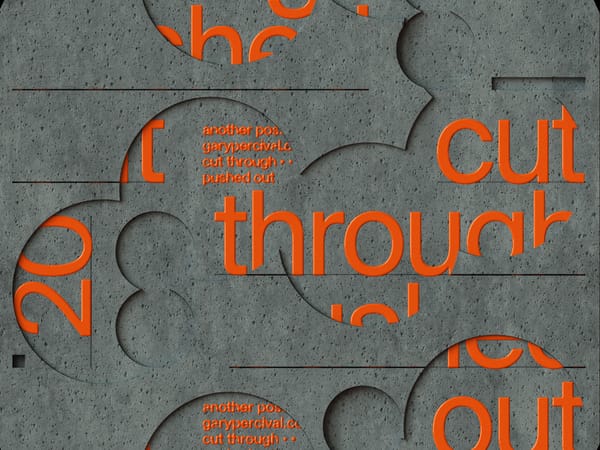Your Urgent Isn’t Everyone’s Urgent
"Your urgent isn’t everyone’s urgent—and that’s okay. The pace you set for yourself doesn’t have to become the pressure you place on others."

Freelancers and creatives live in a world powered by momentum. We chase deadlines, chase inspiration, and chase opportunities before they vanish. The pressure to keep moving—to keep doing—becomes the background noise of our lives.
But here’s the reality that takes most of us far too long to learn:
Your urgent isn’t everyone’s urgent.
Not every email needs an instant reply.
Not every project must match your tempo.
And not every silence means neglect.
We each run on different clocks. Some move quickly; others move deliberately. But creative work—and creative relationships—start to fall apart when we forget that.
The Myth of Shared Urgency
When you work for yourself, you become fluent in pressure.
You’re balancing clients, invoices, timelines, and personal projects, all while trying to stay visible. You know that missed opportunities can sting, that quiet inboxes can mean slow months. So when you care about a project, it feels urgent—because for you, it is.
You send that follow-up email and refresh your inbox. You finish deliverables ahead of schedule, expecting the same pace in return. But days pass. Silence stretches.
That’s when frustration creeps in.
You start reading intention into delay.
“They must not care.”
“They’re holding things up.”
“They don’t get how important this is.”
But often, it’s not about carelessness or indifference. It’s about perspective.
What’s urgent to you is just one line item in someone else’s week. Your top priority might be their tenth.
It’s not personal. It’s logistical.
Urgency Is Contextual
We treat urgency as universal—as though it’s an objective measure. But urgency is always relative to circumstance.
To you, delivering that concept early feels like progress. To your client, it might trigger a new wave of internal reviews that require multiple approvals.
To you, an unanswered email feels like delay. To your collaborator, it might simply be a sign that they’re protecting their focus that day.
We often assume others share our sense of pace because we assume they share our pressures.
But a freelancer’s world—built around flexibility, autonomy, and survival through momentum—runs very differently from a corporate or institutional one, which runs on meetings, layers, and procedure.
The clash isn’t about commitment; it’s about systems.
Once you see that, you stop wasting energy trying to make others operate on your clock.
Urgency and Control
There’s a hidden ego in urgency—a belief that because we’re ready, others should be too.
But readiness doesn’t give you control. It gives you responsibility.
When you’re operating from urgency, you want to move something—to get feedback, to tick boxes, to feel momentum. But creativity doesn’t always thrive on that tempo. Sometimes, the best thing that can happen to your project is for someone else to slow it down.
Maybe they see what you missed.
Maybe they need time to process emotionally what you’ve already processed logically.
Maybe they’re not slower—they’re simply seeing differently.
Learning to accept that is one of the quiet marks of creative maturity: the ability to hold tension without forcing resolution.
But the real challenge begins when that urgency stops being about progress and starts being about control.
The Emotional Cost of Rushing
When everything feels urgent, it’s easy to slide into resentment.
You start to see every delay as an obstruction.
Every slow reply as indifference.
Every pause as a personal slight.
But urgency is exhausting because it places the burden of timing on everyone else. It keeps you in a state of constant reaction—refreshing inboxes, checking DMs, mentally writing the next follow-up before the last one’s been read.
It’s not just impatience; it’s anxiety disguised as productivity.
The truth is, when you live in a perpetual state of urgency, you never give yourself permission to pause. And that lack of stillness erodes your clarity.
Rushing isn’t momentum. It’s motion without reflection.
And motion without reflection doesn’t produce better work—it just produces more noise.
Respecting Other People’s Time Philosophy
People have different philosophies about time.
Some guard it fiercely. They batch emails, plan deep work, and respond once they’ve thought things through.
Others treat time flexibly—bouncing between conversations, creative tasks, and interruptions, thriving in motion.
Neither is wrong. They’re just different.
The challenge is that freelancers often get caught in between—expected to be both flexible and structured, fast and thoughtful, and available and autonomous.
That tension creates friction unless you learn to communicate your rhythm—and respect others’.
If you like to move quickly, be transparent:
“I’ll have this ready by Thursday. No rush on your end—I just like to work ahead.”
If you need a fast turnaround, clarify it upfront:
“Could I get feedback by Friday? That’ll help keep the momentum.”
You can express urgency without imposing it.
That’s how you protect your pace without disregarding someone else’s.
Patience Is a Creative Skill
Creativity requires time—not just for production, but for incubation.
When things move slower than you’d like, it’s tempting to fill the space with action. But sometimes, patience itself is the most productive thing you can practise.
Because ideas need rest. So do people.
A delayed reply might frustrate you today but lead to sharper insights tomorrow. A postponed meeting might give everyone time to rethink something crucial.
In creative work, speed rarely equals quality. Reflection does.
Learning to sit with that pause—to trust that the work is still alive even when it’s quiet—is what separates reactive creatives from resilient ones.
When Urgency Serves You—and When It Doesn’t
Not all urgency is bad. Sometimes, it’s a signal—a spark that tells you what matters.
A sudden burst of motivation, a pressing deadline, a gut-level “this matters now” moment—those can all push you toward progress.
But healthy urgency is inward-facing. It moves you.
Unhealthy urgency is outward-facing. It tries to move everyone else.
The difference is control.
You control your energy. You don’t control others’ responses.
When you spend more time trying to accelerate someone else than improving your own readiness, your focus shifts from creative flow to emotional management.
That’s how burnout begins: not from working hard, but from constantly fighting time you don’t own.
Designing for Different Speeds
Instead of expecting everyone to share your sense of urgency, design your process to accommodate difference.
Create project timelines with built-in breathing room.
Send deliverables early when possible, but remove the emotional expectation of instant response.
Use waiting periods strategically—update your portfolio, draft your next proposal, and refine your process.
If you plan for asynchronous rhythm instead of resisting it, the waiting becomes less about frustration and more about opportunity.
You can’t make time flow faster, but you can make it flow more usefully.
Boundaries Make Urgency Healthier
Urgency becomes toxic when it bleeds into every area of your life.
You can’t turn every task into a crisis. You can’t treat every notification like a fire alarm.
Healthy boundaries protect your clarity.
If a client hasn’t replied, follow up once—not five times.
If a project stalls, reframe the pause as space for development, not doom.
If a collaborator’s slower pace frustrates you, ask for clarity rather than control.
Because boundaries aren’t walls; they’re guide rails that keep you from spiralling into resentment.
Slowness Isn’t Neglect
In creative work, we confuse stillness with stagnation—but they’re not the same.
Just because someone hasn’t replied doesn’t mean they’ve forgotten. Just because they’re slower to react doesn’t mean they’re disengaged.
Sometimes, the best collaborators are the ones who take time to think. They’re not racing to respond—they’re working toward precision.
And sometimes, the best thing you can do is mirror that patience.
When you slow down enough to think, your communication becomes sharper, your revisions fewer, and your relationships stronger.
The Long Game of Creative Patience
In a fast-moving industry, the creatives who last aren’t the ones who sprint—they’re the ones who sustain.
They’ve learnt to differentiate between real urgency and imagined pressure. They’ve stopped trying to control timelines they don’t own.
They move with confidence, not panic.
They follow up thoughtfully, not frantically.
They understand that creative growth is measured not in hours, but in endurance.
Because the real skill isn’t speed—it’s steadiness.
And steadiness is how creative work survives the long haul.
Closing Thought
Your urgent isn’t everyone’s urgent.
And that’s okay.
It doesn’t mean they don’t care. It doesn’t mean you’re wrong for caring deeply. It just means you’re moving to different rhythms.
The work will move when it’s ready. The replies will come when they can. The pace you set for yourself doesn’t have to become the pressure you place on others.
So protect your time, but don’t weaponise it.
Respect your urgency, but don’t demand it be shared.
Because in creative work—as in life—success isn’t about moving faster.
It’s about learning how to move well, together.
Takeaway:
Urgency is personal. Use it to fuel your own focus, not to control others’ pace. True collaboration happens when you respect the rhythm of time that isn’t yours to keep.



